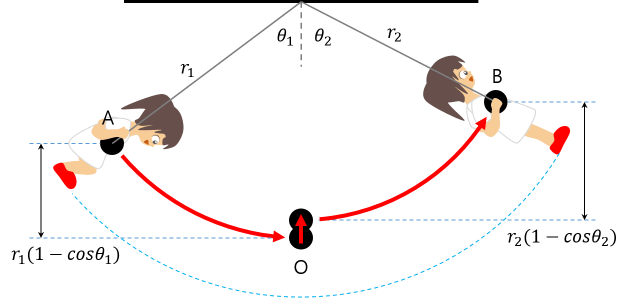Kids have the know-how, but they can’t tell the principal.
“How can you go so high?”
Some principles are difficult to describe in words in the world, even if everyone knows.
I think one of them is how to ride a swing.
Can you explain how to ride a swing with a physics equation?
Standing or sitting at the midpoint of a moving swing changes the length of the pendulum.
In other words, a swing can be thought of as a ‘pendulum that can change its length‘.
Consider the pendulum that moves, as shown in the picture below.

When you going down from A to O
The reduced potential energy equals the increased kinetic energy.
\[ mg r_1 (1 – cos \theta_1 ) = \frac{1}{2}mv^2 \\ v^2 = 2gr_1 (1 – cos \theta_1 ) \]
When you going from O to B.
Reduced kinetic energy equals increased potential energy.
\[ \frac{1}{2}mv^2 = mg r_2 (1 – cos \theta_2 ) \\ v^2 = 2gr_2 (1 – cos \theta_2 ) \]
Change in angle while moving from A to B
The speed at ‘O’ does not changed,
\[ 2g r_1 (1 – cos \theta_1 ) = 2g r_2 (1 – cos \theta_2 ) \\ r_1 (1 – cos \theta_1 ) = r_2 (1 – cos \theta_2 ) \] \[ \therefore \theta_2 = cos^{-1} ({\frac{r_2 – r_1(1 – cos \theta_1)}{r_2}}) \]
How to ride a swing well?
When going down, we need to increase the length of \(r\). (= sit down.)
Conversely, when you go up, you have to stand up.
For example, let’s calculate the increase in angle by substituting the following condition.
- \( r_1 = 3m \)
- \( r_2 = 2m \)
- \( \theta_1 = 45˚ \) (Angle of starting point)
\[ \begin{align} \theta_2 &= cos^{-1} ({\frac{r_2 – r_1(1 – cos \theta_1)}{r_2}}) \\ &= cos^{-1} ({\frac{2 – 3(1 – cos 45˚)}{2}}) \\ &\approx 55.9˚ \end{align} \]
In this case, the angle is increased by about 1.24 times.